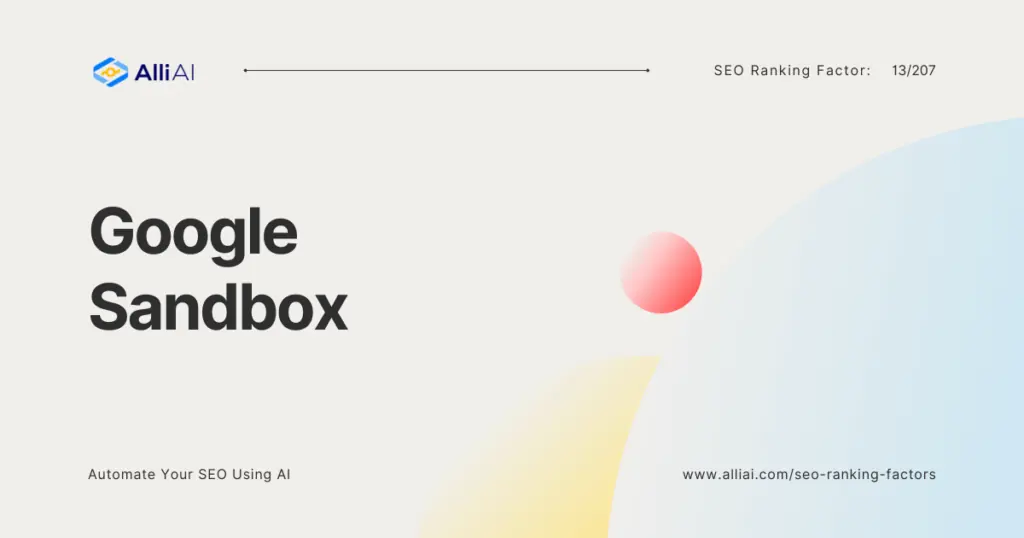What Does Google Sandbox Mean?
The Google Sandbox is an unofficial term used to describe a filter that Google applies to new websites. This filter prevents these new websites from ranking in search results as high as older, more established sites for a certain period of time. This is thought to be a way for Google to discourage spam sites by making it harder for new sites to rank highly quickly, unless they prove their reliability and relevance over time.
Where Does Google Sandbox Fit Into The Broader SEO Landscape?
Google Sandbox is an alleged filter placed by Google on new websites to prevent them from ranking highly in Google’s Search Engine Results Pages (SERPs) immediately after being created. This concept posits that Google holds back new websites, effectively putting them in a “probation” period to deter spam sites from ranking quickly. While not officially confirmed by Google, many SEO professionals have observed this phenomenon, especially when new websites struggle to rank for competitive keywords during their initial months despite having good content and robust SEO strategies. The Sandbox effect, if true, impacts strategic planning in SEO, primarily focusing on steady content development, link building, and using long-tail keywords to gradually build site authority and overcome any initial hurdles set by such a filter.
Real Life Analogies or Metaphors to Explain Google Sandbox
1. Garden Sandbox: Imagine Google Sandbox as a gardening sandbox where young plants (new websites) are placed. In this contained space, gardeners (Google’s algorithms) monitor how well these plants grow, ensuring they are healthy and strong enough before being transplanted into the vast garden (search engine results pages) where mature plants thrive.
2. Training Wheels on a Bicycle: Google Sandbox functions like the training wheels on a bicycle. When a new cyclist (new website) starts riding, the training wheels (sandbox) help stabilize the bike, preventing it from tipping over while the rider learns the basics of balancing and pedaling. Once confidence and skills are gained, the training wheels are removed, allowing the bicycle to join the fast-moving traffic (SERPs).
3. Broadway Debut: Think of Google Sandbox as the off-Broadway stage for Broadway shows. New shows (websites) start off-Broadway to see how well they perform with a smaller audience and iron out any issues. If they prove their worth, they make the move to Broadway, the main stage where they can shine in front of a larger audience (gain higher search rankings).
4. College Freshman: Google Sandbox is akin to a college’s freshman year, where new students (websites) are tested through various academic challenges and social adaptations in a somewhat protective environment before they are deemed ready to take on more rigorous upper-class courses and declare a major (rank in search results).
How the Google Sandbox Functions or is Implemented?
The Google Sandbox is an unofficial term referring to an observation that newly created websites may initially experience a period of suppressed rankings in Google’s search engine results page (SERP). While Google has not officially confirmed the existence of a sandbox, many SEO professionals posit its use as a means to deter spam sites from rising quickly in search rankings by employing manipulative SEO tactics. Here’s an exploration of its theoretical mechanics:
1. Initial Detection:
– New websites upon launching or newly acquired domains that suddenly change content significantly trigger an evaluation mechanism within Google’s algorithm.
2. Probation Period:
– During this period, the website is monitored for its quality of content, adherence to Google’s webmaster guidelines, and its attempt to engage in organic link-building practices rather than aggressive spammy techniques.
3. Observation of Signals:
– Google pays attention to various signals such as engagement metrics (bounce rate, time on site), the velocity and quality of inbound links, content update frequency, and social signals.
4. Gradual Trust Gain:
– The site may be subject to restricted growth in SERP as Google evaluates its trustworthiness and value over time. Essentially, the Sandbox can be seen as a trial period during which the website needs to prove itself.
5. Escaping the Sandbox:
– Upon favorable evaluation—once Google’s algorithms decide that the site is worthy, authentic, and adds value to users—the restrictions are lifted, usually leading to improvements in SERP rankings.
The duration of stay in the Google Sandbox varies, with hypotheses suggesting it could range from several weeks to several months, depending primarily on the level of competition in a respective niche and the quality of signals a site sends to Google.
Impact Google Sandbox has on SEO
Google Sandbox is an alleged filter that Google applies to new websites that prevents them from ranking in search results immediately. This means that even if a new website is well-optimized for search engines, it might not appear in the top results for its target keywords until it exits the Sandbox period. This latency can last from a few weeks to several months, during which time the visibility of the website in search results is significantly reduced.
This imposed filter affects SEO performance by delaying the time it takes for a new website to start accumulating organic traffic, which can be crucial for business success. Since the website does not rank well in the initial stages despite having good content and SEO strategies, it struggles to reach its target audience, which can hinder early user engagement and growth.
In terms of user experience, this delay in ranking does not directly affect how users interact with the website itself once they find it. However, it does impact the site’s visibility, so fewer users will be aware of the website and thus interaction will be lower than potential during the Sandbox period.
SEO Best Practices For Google Sandbox
1. Choose a niche or industry with lower competition to reduce the impact of Google Sandbox.
2. Select relevant and specific keywords; use tools like Google Keyword Planner or SEMrush for research.
3. Optimize your website’s on-page SEO elements, such as title tags, meta descriptions, header tags, and URLs, incorporating primary and secondary keywords.
4. Produce high-quality, original content regularly that provides value to your audience; include blog posts, tutorials, videos, and infographics.
5. Enhance your website’s user experience (UX) by ensuring it is mobile-friendly, has fast loading times, and a logical navigation structure.
6. Build a robust backlink profile gradually by acquiring links from reputable and relevant websites.
7. Utilize social media platforms to promote content and increase visibility and engagement.
8. Implement Google Analytics and Google Search Console to monitor website performance and make data-driven adjustments.
9. Encourage customer reviews and ratings especially on Google My Business if applicable.
10. Stay patient; continue refining your SEO strategy and wait out the initial period where visibility may be lower.
Common Mistakes To Avoid
1. Launching Too Quickly: Abruptly launching a large number of pages can signal to Google that your site is low quality or spammy, potentially extending the duration in the sandbox.
2. Acquiring Low-Quality Backlinks: Gaining backlinks from suspicious or low-quality sources may make Google perceive your site as manipulative or untrustworthy.
3. Ignoring On-Page SEO: Neglecting to optimize meta tags, content quality, user experience, and mobile optimization can negatively influence your site’s reputation and ranking.
4. Over-Optimization of Keywords: Stuffing content with excessive keywords can trigger penalties from Google, pushing your site further down in rankings.
5. Lack of Content Updates: Infrequently updated or stale content can hinder your site’s ability to gain credibility and move out of the sandbox phase.
6. Neglecting Technical SEO: Overlooking issues like slow site speed, crawl errors, and unoptimized sitemaps can degrade user experience and search engine visibility.
7. Poor Content Quality: Publishing low-quality or plagiarized content can result in search engines viewing your site as less authoritative or reliable.
8. Rapid Link Building: Building too many backlinks too quickly can appear manipulative to Google, potentially causing flags or penalties.
9. Focusing Solely on Quantity of Content: Prioritizing quantity over quality can dilute the perceived value of your website in the eyes of search engines.
10. Ignoring Local SEO (if applicable): For local businesses, failing to optimize for local search (e.g., Google My Business, local keywords) can delay ranking improvements.
To steer clear of these pitfalls, focus on steadily building high-quality content, secure reputable backlinks gradually, ensure all technical and on-page SEO elements are optimized, and update content regularly while monitoring performance metrics to guide adjustments.






